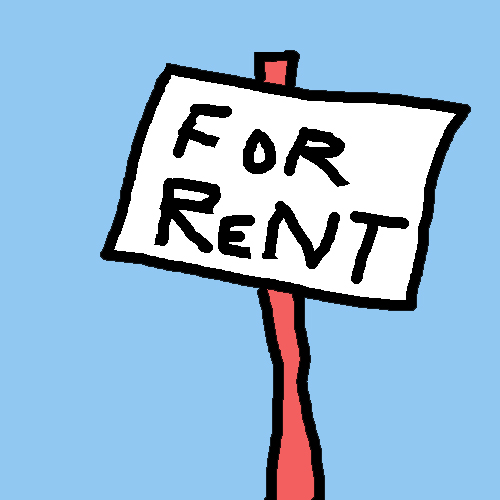SELL or RENT
Most artists have two tasks going on at the same time. First is making their art, and second is finding the place where it will go. The easy option for the second task is just keeping it for themselves or giving it away to friends and family. But that doesn’t pay your rent.

About ‘SELLING’ your art.
The first problem with ‘selling’ is finding someone who will buy the art. That is rather tricky because it demands a completely different mental process. The art becomes a ‘product’ in business terminology. The potential happy collector is a ‘customer’. Many artists will baulk at the business mindset.
So they might find an agent who will do the job for them. An art gallery is nice. However it is not that easy to find one that wants to do the selling without taking a big portion of the income with the artist taking a small percentage of the sale price.
Plus, the gallery will expect the artist to supply the artwork without any competition. That means that the artist does not use competitive galleries, or sell directly to any prospective customer. And they don’t get the benefit of first-hand reaction from the buyers.
So many artists choose to do the selling themselves. They get the valuable feed-back directly from their collectors. They keep all the sale income. But they have to learn ‘how to do the selling’ themselves. And there are lots of ways to do this. More about this in future posts.
However there is another option, RENTING.
Don’t sell…rent-out instead. One of the interesting routes to getting paid as an artist is to hire your art instead of finding someone who will buy it.
This usually applies when you target business and corporate customers rather than private collectors. Businesses are used to renting premises etc. and they can prefer a hire solution for several reasons.
One. They don’t have such a large financial outlay in the beginning.
Two. They can expect to have a regular exchange option built in.
Three. They are not buying with an investment motive. But instead they have a prestige and happy workforce benefit.
So a hiring arrangement can be just the ticket.
But it is even more difficult to find someone to rent to. Again an agent is usually the favourite option.
This is what the person hiring out has to do.
One. Find an interested ‘hirer in’.
Two. Get their attention by being available and being known.
Three. Stimulate the ‘hirer-ins’ interest by having good product and value.
Four. Provoke their desire to hire in by satisfying their benefits. They were small financial outlay, exchange option, and prestige and happy workforce.
Five. Deliver and hang the complete framed art. Maintain if and where necessary. Keep up and on top of all the extra paperwork.
Renting to private sector.
This possibility has not been tried out much. Most private collectors want to own the artwork. They enjoy finding it, choosing it, displaying it, and therefore ‘owning it’ for keeps. They will not usually think about renting and giving the art back to the artist.
But there is another possibility and that might be called ‘trading up’. This is where a potential collector likes the artist’s work but cannot afford it. So they cannot have it, yet. But one day they hope that they will.
So the artist offers the potential collector the chance to hire and experience the art for an affordable monthly arrangement. Then after an agreed or suggested period of time the total rent paid so far is transferred to make the purchase at the original price.
This obviously depends a lot on the price of the art for sale in the beginning and the monthly amount paid before the purchase chance. The benefit for the artist is they own the piece that is being rented out until it is actually all paid for and the sale completed. So they can get it back and keep the rent already paid if the collector wants a different piece or declines ownership.
The benefit to the collector is that they have the art for a while without laying out the whole purchase price up front. They can get more choice of bigger, more expensive, or better artwork. They get it quicker and they will not waste their money if they eventually buy.
The advantage to the artist is that they sell more artwork because more collectors can afford their artwork. But the money comes in slower. Although this can be seen as another advantage because income is more predictable if there is an agreed monthly payment.
Conclusion.
It can be worth it if an artist develops an arrangement and system of rental to corporate renters and private renters. But most artists do not.



